Hands On with the Final NVIDIA Shield Hardware, Update: Now with Video
by Brian Klug on June 11, 2013 2:20 AM EST- Posted in
- Smartphones
- Android
- Mobile
- Tablets
- Android 4.2
- Shield
- Tegra 4
- NVIDIA
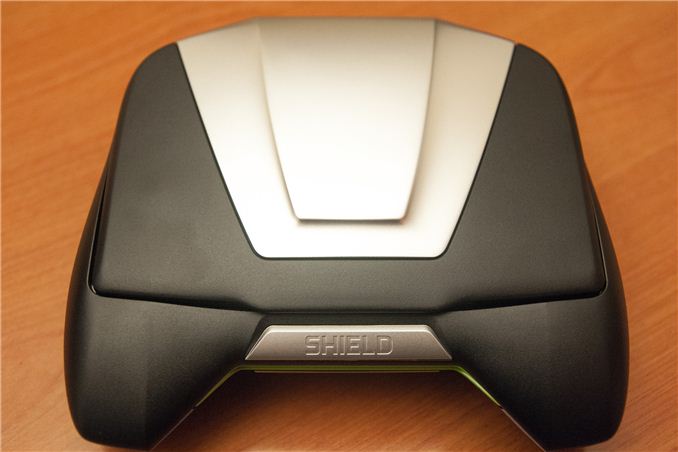
It seems like forever since CES 2013 when we first laid eyes on and played with NVIDIA’s Project Shield. Time flies, and since then Shield has dropped the Project and become just NVIDIA Shield. It’s not every day that we get to see a product go from being an early prototype with its own set of issues to final hardware ready to go into manufacturing in large numbers, but with Shield we’ve been given that very opportunity. Both Anand and myself got a chance to take a look at NVIDIA’s final Shield hardware.
Shield is of course NVIDIA’s reference Tegra 4 tablet turned part gaming controller slash PC streamer, part handheld gaming console running Android. Inside is of course the Tegra 4 SoC with four ARM Cortex A15s running at up to 1.9 GHz and 72 core GPU built on TSMC’s 28nm HPL process. It’s topped by a 5-inch 720p 294 PPI display and comes with 16 GB of internal storage, 2 GB of DDR3L, 2x2:2 802.11n dual band WiFi, and a microSD card slot. Atop all of that runs Android 4.2.1, but 4.2.2 is coming. Again Shield will always basically be running the latest stable version of the NVIDIA Tegra 4 BSP (Board Support Package) software, and updates come from NVIDIA. The specs really don’t tell the whole story though – and they haven’t changed – the key is in the subjective feel and ergonomics of Shield as a controller and its ability to be a standalone gaming console.
To say that Shield has come a long way is to put it lightly. The early hardware was very prototype-y, with a D-Pad that was mushy, triggers that didn’t feel right, analog sticks that weren’t tuned yet, and buttons that didn’t feel communicative enough. Even at Google I/O, NVIDIA was showing off Shield with hardware that wasn’t quite final yet, with a mushy D-Pad and analog sticks that still didn’t feel quite right to me.
The final Shield is much, much better.
NVIDIA’s tuning to the Shield hardware focused on pretty much all the points we touched on as concerns regarding the controller. I find myself drawing comparisons between Shield and the Xbox 360 controller since it reflects my almost-ideal controller. On the final Shield hardware the analog sticks have nubs on them and have a good amount of resistance, and are textured nicely.
The all-important D-Pad is much more communicative and clicky. I’m not much of a platform player however so I’m not sure if it will appease everyone, I’m also not sure if this is a hat switch or not, but I had no problem knowing whether I was pushing up down left or right. The triggers on the back likewise have much better resistance, and both bumpers have great crisp breaks. The remainder of the buttons likewise are clicky and responsive.
Talking about a controller for me isn’t so much finding things that are well done as things that fade into the experience and can be taken for granted, and in my hour or so with Shield I can’t think of anything that would frustrate me. That said it’s hard to really know where a controller or interface is going to fatigue you until you’ve used it for a few hours.
That brings me to the weight and mass question. NVIDIA moved around the batteries inside Shield, but the overall balance still feels good. What’s really different to me about Shield versus holding any of the other controllers (PS3, Xbox 360 Wired or Wireless) is how I can rest the whole console in basically both palms. The topology of the underside essentially rests on a shelf formed by your fingers. It’s hard to describe, but I’m reminded of my favorite Xbox 360 controller by Scuff gaming with the underside buttons which make you put your hands that way.
The final Shield hardware also has a significantly beefier display hinge, which makes the whole thing feel more snug and solid. There’s also that new metal Shield logo at the bottom between the front air intake (yes, Shield’s Tegra 4 remains actively cooled with a fan that kicks in after it crosses a certain temperature). If I could describe the final Shield hardware it honestly would follow that language – tougher and beefier and less delicate.
The buttons now navigate through Android much more effectively as well. Left and right bumper take you through pages in the launcher, reminiscent of the navigation on the Xbox 360. The left analog stick works like a virtual mouse and pops up a cursor, the D-Pad accordingly works like you’d expect. I found myself using those controls more than the touchscreen, though there are inevitably actions (both in games in Android) which require you take a hand off of balancing Shield and interact with the display.
I still however find myself wishing that the LCD display was bigger. Not because 5-inches diagonal is too small, or 720p too low res, but because the large black bezel around the thing makes it still look a rather awkward. I’m surprised NVIDIA couldn’t cut a deal with LG for some of their bigger 1080p panels (like the one from the Optimus G Pro) but I suspect there’s no easy way to get something better without compromising price point. The form factor of Shield also necessitates a landscape layout, and landscape layouts have been something of a rarity in Android since the departure of handsets with QWERTY hardware keyboards. There’s more than a few apps which only work in portrait or have some view which works only in portrait, but hopefully NVIDIA and Shield both will persuade some of this to change back.
The remainder of the equation for Shield’s viability as a console remains a software one, and here NVIDIA has to rely on the Android platform’s ability to deliver games customers want. Shield is effectively a gaming console running Android, something everyone talks about but nobody has really executed or delivered on entirely (sorry Ouya) – at least yet. Shield will ship with a few gaming related preloads, Sonic 4 Episode II THD and Expendable: Rearmed for games, plus Twitch TV and Hulu+ apps optimized for Shield. Of course there’s Google Plus and NVIDIA TegraZone as well. Beyond that though NVIDIA is relying on Android developers to make games which work and play well on Shield’s rather unique form factor. At launch, NVIDIA claims it will have 30 optimized titles available which work well with the controller and are optimized for landscape displays. Of course any game on Google Play with controller support will work on Shield.
The PC streaming aspect remains a second way to use Shield, and it’s a big sell in for a beefy desktop GPU, even if Shield becomes little more than a video decode sink and controller. In this setup, your NVIDIA based PC actually handles all of the 3D rendering before encoding the frame buffer as a video stream and sending it over WiFi to Shield. Presently, this personal GPU cloud only works in a 1-to-1 (one desktop to one Shield) ratio and it's only designed for local use.
Latency is impressively low and there’s minimal to no hitching. I played Borderlands on Shield connected to a Falcon Northwest box with GeForce Titan inside and found it more than playable. The obvious end goal however is to use some GPUs virtualized in the cloud with GRID and stream games to Shield, but it’s not quite there yet.
I find myself wishing that NVIDIA could launch Shield as a Nexus Experience device of some kind as a flagship platform with the new Google Play gaming services APIs as the context, but I’m not sure that’s in the cards. NVIDIA is steadfast with its “late June 2013” ship date, price remains $349 for NVIDIA’s foray into handheld gaming with Tegra 4.


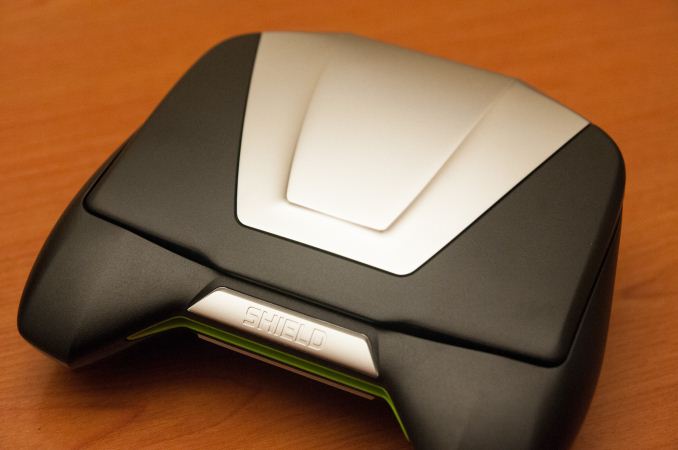

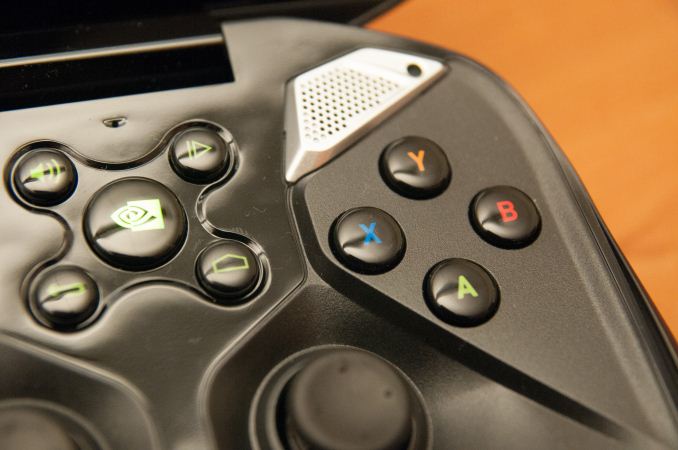
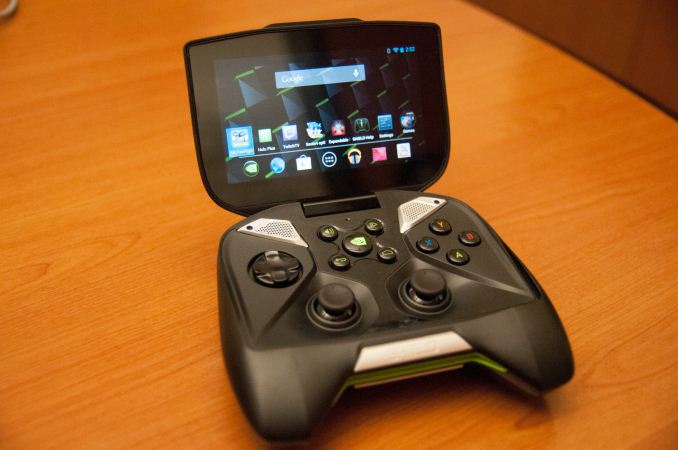
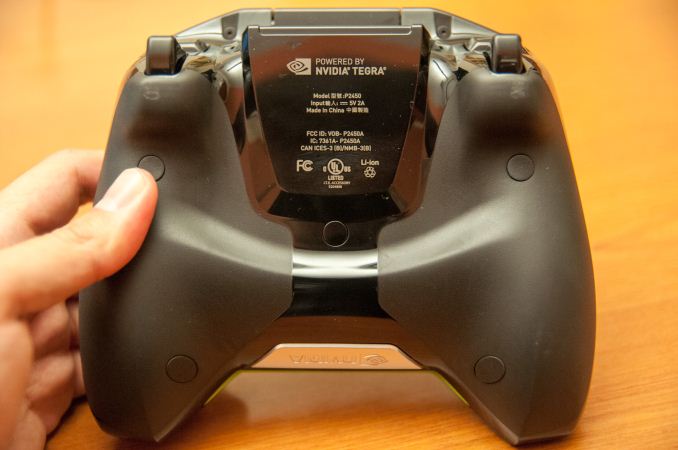














46 Comments
View All Comments
steven75 - Tuesday, June 11, 2013 - link
I don't understand this use case. Do you not have TVs in your house?aicom - Tuesday, June 11, 2013 - link
I do have TVs, but they aren't as flexible as a full Android device. I could get an Apple/Google TV STB, but then I lose portability and flexibility. I can walk around the house with a Shield browsing the web, playing games, or watching videos with a quad-core A15 keeping things snappy.I guess my use case for it is like a very tiny but powerful Android netbook. When I'm doing most of my real work, I'll be on a larger 15" laptop where a keyboard is definitely a requirement. For media consumption, casual Internet browsing, and gaming, the Shield would be ideal because I would rather have to deal with an onscreen keyboard than an onscreen gamepad.
fteoath64 - Tuesday, June 11, 2013 - link
@aicom: I concur!. Shield will do well and probably kick off the NDS and potentially PS Vita users as well due to its choices in games and versatility as a house-hold walk around device. I stayed away from driving games on Android since without hardware controllers and keys, they are hard to control properly, so Shield fits the portable gaming mode there. Why need a large TV and noisy sound when you can headphone and blast your way into driving simulators!. Laptop and desktop have their purposes and so do smart-phones with large screens. Few would find it ideal to watch a movie on anything smaller than a 7inch tablet, so the Shield has a fit in the usage model. Yes, people still want Xbox for Kinect and PS4 for its awesome games. It is diversity of choices that makes the industry interesting since no one box does it all. And if it does, it does so for one solitary person alone.So why get a large screen TV when I can hdmi from Shield to my 24inch IPS monitor for Shield gaming ?.
goinginstyle - Wednesday, June 12, 2013 - link
Save yourself $329 and buy a decent case for your Nexus 7. It will allow you to watch your movies or other media in a much better fashion than constantly holding the Shield at the right angle, which based on the design I played with at CES had very limited panel movement. Also, once the fan kicks in your hands will appreciate a Nexus 7 in a case.glenricky - Tuesday, June 11, 2013 - link
add 50 and you will get PS 4alexvoda - Tuesday, June 11, 2013 - link
This may me DoA due to costing $349 but the price makes sense.You should compare it to a Quad Core A15 5" unsubsidized phone and the price becomes a lot more reasonable.
Death666Angel - Tuesday, June 11, 2013 - link
That phone is much more useful and essential for many people.GTRagnarok - Tuesday, June 11, 2013 - link
Not interested in it. Just want to see benchmarks!Silma - Tuesday, June 11, 2013 - link
The PS Vita costs $249 and already has a hard time selling.The PS4 will be only $50 more than the Shield.
I think people will be much more likely to spend $349 on a smartphone, a tablet or a PS4/Xbox One.
joel4565 - Tuesday, June 11, 2013 - link
Not only that, but isn't the PS Vita supposed to be able to stream all of the PS4 games? And to me that is the Shield's biggest selling point, is streaming full games. So if Sony can pull it off with the cheaper Vita, then they might take a lot of the wind from Nvidia's sails.